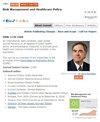Analysis of the Current Status of Nurses’ Knowledge of Pressure Injuries and Factors Influencing It in Shaanxi Province, China: A Cross-Sectional Study
IF 2.7
4区 医学
Q2 HEALTH CARE SCIENCES & SERVICES
引用次数: 0
Abstract
Background: Pressure injuries are present in all healthcare environments and not only pose a significant health risk to individuals but also impose a heavy economic burden on society and families. Nurses, as the primary caregivers responsible for the prevention and management of pressure injuries, have knowledge that directly determines the incidence of pressure injuries.Aim: To understand the current status of nurses’ knowledge of pressure injuries in Shaanxi Province and the factors influencing it.
Design: A cross-sectional survey.
Methods: In April - May 2022, 16,599 nurses from hospitals at all levels in Shaanxi Province were selected as survey subjects by convenience sampling method. They were surveyed using the general information questionnaire and the Pieper-Zulkowski pressure injury Knowledge Questionnaire through the Questionnaire Star platform.
Results: 16,599 nurses had a pressure injury knowledge score of (44.32± 10.11). Wound description and pressure ulcer staging dimensions were less than 60% correct. Comparison of pressure injury knowledge scores of nursing staff with different genders, hospital levels, titles, education, whether they were specialized nurses in wound stoma when they last attended a lecture on pressure ulcers, when they last read literature or books on pressure ulcers, and whether they ever looked for information about pressure ulcers on the Internet showed that the differences were statistically significant (P < 0.05), which were the influencing factors of the knowledge scores of the nursing staff in Shaanxi Province.
Conclusion: Clinical nurses’ awareness of stress-related injuries still needs to be improved, and nursing administrators can improve the quality of pressure-related injury care by increasing nursing staff’s awareness through continuing education, tiered training, and other measures.
中国陕西省护士对压力性损伤的认知现状及影响因素分析:横断面研究
背景:压力性损伤存在于所有医疗环境中,不仅对个人健康构成重大威胁,也给社会和家庭带来沉重的经济负担。护士作为预防和处理压伤的主要护理人员,其知识水平直接决定着压伤的发生率。目的:了解陕西省护士对压伤知识的掌握现状及影响因素:设计:横断面调查:方法:2022 年 4-5 月,采用方便抽样法从陕西省各级医院抽取 16599 名护士作为调查对象。通过问卷星平台,使用一般信息问卷和Pieper-Zulkowski压伤知识问卷对他们进行调查:16599名护士的压伤知识得分为(44.32±10.11)分。伤口描述和压疮分期尺寸的正确率低于 60%。比较不同性别、医院级别、职称、学历、最近一次参加压疮知识讲座时间是否为伤口造口专科护士、最近一次阅读压疮相关文献或书籍时间、是否曾上网查询压疮相关信息的护理人员压疮知识得分,差异有统计学意义(P <0.05),是影响陕西省护理人员压疮知识得分的影响因素:临床护士对压力相关性损伤的认识还有待提高,护理管理者可通过继续教育、分层培训等措施提高护理人员对压力相关性损伤的认识,从而提高压力相关性损伤的护理质量。
本文章由计算机程序翻译,如有差异,请以英文原文为准。
求助全文
约1分钟内获得全文
求助全文
来源期刊

Risk Management and Healthcare Policy
Medicine-Public Health, Environmental and Occupational Health
CiteScore
6.20
自引率
2.90%
发文量
242
审稿时长
16 weeks
期刊介绍:
Risk Management and Healthcare Policy is an international, peer-reviewed, open access journal focusing on all aspects of public health, policy and preventative measures to promote good health and improve morbidity and mortality in the population. Specific topics covered in the journal include:
Public and community health
Policy and law
Preventative and predictive healthcare
Risk and hazard management
Epidemiology, detection and screening
Lifestyle and diet modification
Vaccination and disease transmission/modification programs
Health and safety and occupational health
Healthcare services provision
Health literacy and education
Advertising and promotion of health issues
Health economic evaluations and resource management
Risk Management and Healthcare Policy focuses on human interventional and observational research. The journal welcomes submitted papers covering original research, clinical and epidemiological studies, reviews and evaluations, guidelines, expert opinion and commentary, and extended reports. Case reports will only be considered if they make a valuable and original contribution to the literature. The journal does not accept study protocols, animal-based or cell line-based studies.
 求助内容:
求助内容: 应助结果提醒方式:
应助结果提醒方式:


